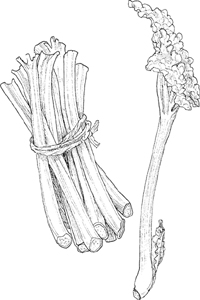
BOTANICAL NAME: Rheum rhabarbarum
FAMILY: Polygonaceae

Queen Victoria’s ascension to the throne gave rise to a profusion of English fruits and vegetables named in her honor. Victoria rhubarb, a charming red variety introduced in 1837, is still considered one of the most excellent for its rich, tart flavor. It is also one of the most widely grown of all the English heritage varieties. Victoria boasts huge, thick stalks, some two and a half to three feet long, and a greenish skin heavily blotched with red. The flesh is green and pleasantly tart, not quite as sweet as many other red varieties, which is why it also makes excellent rhubarb wine.
Philadelphia seedsman Robert Buist recommended Victoria in his 1847 Family Kitchen Gardener—one of the first Americans to do so—and also noted that he had developed a new American variety from it which he called Large Early Red. This is said to be the same rhubarb now commonly known as strawberry rhubarb. Elizur E. Clark of New Haven, Connecticut, developed yet another rhubarb, which he dubbed Washington, from a seedling of Victoria. It featured green stems and was introduced commercially in 1861. In short, Victoria has provided horticulturists with a rich breeding stock for multitudes of new types and flavors. But none of them have ever surpassed the longevity and popularity of Victoria itself. It remains one of the heaviest-producing rhubarbs still raised for the commercial market in England and the United States.
Honors for its development go to Joseph Myatt of Manor Farm, Deptford, England, a gentleman who devoted much of his life to breeding all sorts of fruits, especially strawberries. His British Queen and Eliza strawberries were well known in nineteenth-century England, and perhaps it is not coincidental that both strawberries and rhubarb made a perfect match in the pies and whips so popular during that period (and still do). Frederick Bishop’s 1856 The Wife’s Own Book recommended preparing tarts with pureed cooked rhubarb or chopping up the stems to resemble the texture of gooseberries—a technique that works quite well with green-stemmed varieties like Early Champagne (page 70). What we do not often see in the Victorian recipes is the combination of red rhubarb and other red fruit such as cherries, ripe gooseberries, or red currants.
Many Victorians suffered from gout, which meant that rhubarb —like gooseberries and currants—was on the list of forbidden foods. The addition of raspberries or ginger was thought to diminish the gout-irritating acids, and fresh cream better yet. However, rhubarb is one of those plants that absorbs the flavors of everything mixed with it without enhancing its own, so it must be used wisely in any recipe where additional fruit is called for. When used sparingly, red currants will bring out the flavor of rhubarb more than any other fruit with which it is cooked. I heartily recommend red currants and strawberries with Victoria, even when it is just stewed as a compote or prepared as a sauce for ice cream or mousse. In my garden this means the large-fruited heirloom red Versailles currants and a copious helping of freshly picked frais de bois (wild strawberries). A small dash of grated nutmeg and some zest of orange completes the balance of flavors.